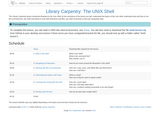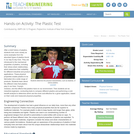
Library Carpentry lesson to learn how to use the Shell. This Library Carpentry lesson introduces librarians to the Unix Shell. At the conclusion of the lesson you will: understand the basics of the Unix shell; understand why and how to use the command line; use shell commands to work with directories and files; use shell commands to find and manipulate data.
- Subject:
- Applied Science
- Information Science
- Mathematics
- Measurement and Data
- Material Type:
- Module
- Provider:
- The Carpentries
- Author:
- Adam Huffman
- Alex Kassil
- Alex Mendes
- Alexander Konovalov
- Alexander Morley
- Ana Costa Conrado
- Andrew Reid
- Andrew T. T. McRae
- Ariel Rokem
- Ashwin Srinath
- Bagus Tris Atmaja
- Belinda Weaver
- Benjamin Bolker
- Benjamin Gabriel
- BertrandCaron
- Brian Ballsun-Stanton
- Christopher Erdmann
- Christopher Mentzel
- Colin Sauze
- Dan Michael Heggø
- Dave Bridges
- David McKain
- Dmytro Lituiev
- Elena Denisenko
- Eric Jankowski
- Erin Alison Becker
- Evan Williamson
- Farah Shamma
- Gabriel Devenyi
- Gerard Capes
- Giuseppe Profiti
- Halle Burns
- Hannah Burkhardt
- Ian Lessing
- Ian van der Linde
- Jake Cowper Szamosi
- James Baker
- James Guelfi
- Jarno Rantaharju
- Jarosław Bryk
- Jason Macklin
- Jeffrey Oliver
- John Pellman
- Jonah Duckles
- Jonny Williams
- Katrin Leinweber
- Kevin M. Buckley
- Kunal Marwaha
- Laurence
- Marc Gouw
- Marie-Helene Burle
- Marisa Lim
- Martha Robinson
- Martin Feller
- Megan Fritz
- Michael Lascarides
- Michael Zingale
- Michele Hayslett
- Mike Henry
- Morgan Oneka
- Murray Hoggett
- Nicola Soranzo
- Nicolas Barral
- Noah D Brenowitz
- Owen Kaluza
- Patrick McCann
- Peter Hoyt
- Rafi Ullah
- Raniere Silva
- Ruud Steltenpool
- Rémi Emonet
- Stephan Schmeing
- Stephen Jones
- Stephen Leak
- Stéphane Guillou
- Susan J Miller
- Thomas Mellan
- Tim Dennis
- Tom Dowrick
- Travis Lilleberg
- Victor Koppejan
- Vikram Chhatre
- Yee Mey
- colinmorris
- csqrs
- earkpr
- ekaterinailin
- hugolio
- jenniferleeucalgary
- reshama shaikh
- sjnair
- Date Added:
- 08/07/2020
